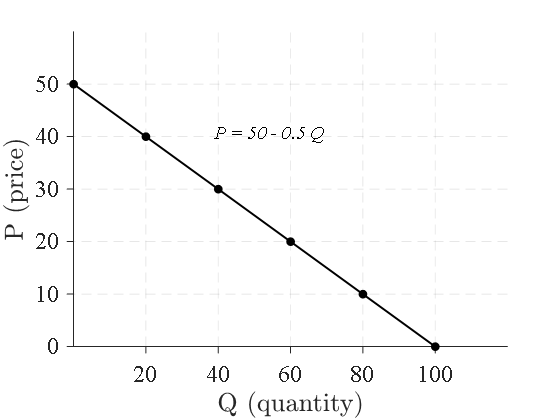Section 3: Practise questions
Question 1
Consider a linear function: $$y=a+bx$$ Suppose the rule of the function is such that when \(𝑥\) is \(60\), \(𝑦\) is \(66\) and when \(𝑥\) is \(100\), \(𝑦\) is \(90\). (That is, you need to consider a linear function which passes through \((60, 66)\) and (\(100, 90)\). What are the values of \(𝑎\) and \(𝑏\) in the function? Draw the graph of the function.
The slope of the function $$b = \frac{90 - 66}{100 - 60}$$ $$b = \frac{24}{40}$$ $$b = 0.6$$
When \(x=\)\(100\), \(y=\)\(90\), and \(b=\)\(0.6\) (all these numbers must satisfy the function): $$90 = a + 0.6(100)$$ $$a = 30$$
The linear function that passes through \((60, 100)\) and \((66, 90)\) is: $$y = 30 + 0.6x$$ Which is an upward-sloping line with the slope \(0.6\) and the vertical intercept \((0,30)\).
Figure 5

Question 2
Draw the graph of the function: $$C = 100 + 0.8y$$ Where, \(C\) is consumer spending and \(Y\) is income.
Here \(Y\) is income which is non-negative.
The given consumption function is a linear function with the slope \(0.8\) and vertical intercept \((0,100)\). See Figure 6.
Figure 6

Question 3
Given the demand function, $$Q = 100 - 2P$$ Derive the slope of the inverse demand function. Draw the inverse demand function.
Here, $$Q = 100 - 2P$$ $$2P = 100 - Q$$ $$P = 50 - 0.5Q$$
The slope of the inverse demand function is \(-0.5\), and the vertical intercept is \((0,50)\).
Figure 7


UWO Economics Math Resources by Mohammed Iftekher Hossain is licensed under a Creative Commons Attribution-NonCommercial-ShareAlike 4.0 International License.